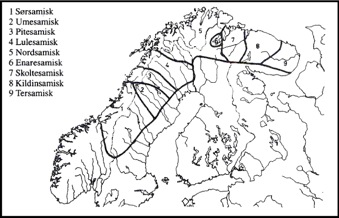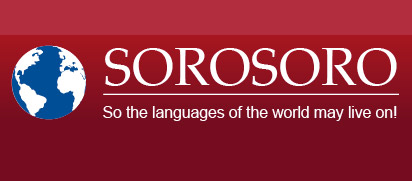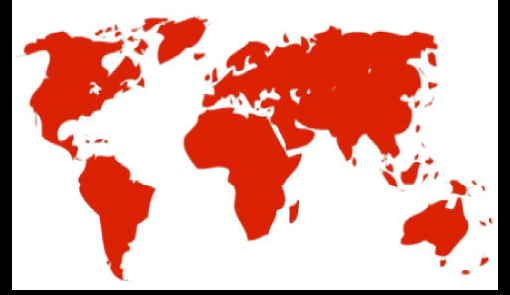Print  |
|


Sami languages
Data collected by the Humboldt University of Berlin, for the DoBes programme.
Data on Sami languages
Alternative names: Saami, Sámi, Saame, Samic, Saamic.
Note: The terms “Lappish”, “Lappic” and “Lapp” are considered derogatory and are therefore falling out of use. “Saami” or “Sàmi” are the terms that speakers use for these languages. In English, the word “Sami” tends to be used to describe the languages and the people who speak these languages.
Where are Sami languages spoken?
These languages are spoken in the far north of Europe in a cross-border region which includes northern Norway, Sweden, Finland and the Kola Peninsula of Russia. This region is generally called “Lapland” or “Sápmi”, which is the name used by the Sami people. Lapland (the Laponian area) is the largest UNESCO world heritage site on earth; the last great natural site to be preserved in Europe.

Photo credit : DoBes, © Aarset & Bjørklund.
Who speaks Sami languages?
The Sami are a minority, cross-border people: in other words, they are a people without a state. There are many theories as to the origins of the Sami people. The scientific community postulates that their presence in the north can be traced back for more than 12 000 years.
The Sami, despite the differences between various groups and speakers within the Sami population, consider themselves to be one people, as demonstrated by the founding declaration of the Sami Council: “We, the Sami, are one people, united by our own culture, our language and our history, living in lands which we alone have inhabited and worked on since time immemorial and as far back as History goes”.
(Estimated) Total number of speakers:
Around 35 000, according to DoBes.
Classification:
Uralic family, Finno-ugrian languages, Finno-lappic group, Sami branch.
Although spoken in Europe, these languages are not Indo-European languages. They are part of the same linguistic family as languages such as Hungarian, Estonian and Finnish.
Internal classification:
Traditionally, Sami languages are divided into two main groups, the west and the east :
The West Sami group includes:
Southern Sami 300 – 500 speakers according to DoBes
Ume Sami Less than 20 speakers according to DoBes
Lule Sami 2 000 – 3 000 speakers according to DoBes
Pite Sami Less than 20 speakers according to DoBes
Northern Sami 30 000 speakers according to DoBes
The East Sami group includes:
Kemi Sami extinct
Inari Sami 300 – 500 speakers according to DoBes
Akkala Sami probably extinct since 2003
Kildin Sami 300 – 700 speakers according to DoBes
Skolt Sami 300 – 500 speakers in Finland, fewer than 20 speakers in Russia
Ter Sami 6 speakers according to DoBes
Within each of these groups, the languages are all quite closely related and in fact, the two groups have long been considered to be two large dialectal groupings. Most people, including the majority of specialists, consider these to be “variants of Sami”, much like other closely related languages.
Are Sami languages endangered?
Yes. All Sami languages could soon disappear. Out of the 11 historically attested Sami languages, only 9 are still spoken. Among these, it is highly likely that Akkala Sami has been extinct since the beginning of the 21st century. Ter Sami is almost extinct: there are only half a dozen speakers remaining, and all are elderly. Ume Sami and Pite Sami are also on the brink of extinction and all other Sami languages are endangered.
Northern Sami, which is the most commonly spoken Sami variant, is also considered by UNESCO to be an endangered language.
Currently, education, official documents and the media use Northern Sami almost exclusively. This variant is used as a de facto “official language” and the most significant efforts have gone into the development of this particular language, to the detriment of other Sami languages. In addition to this, description and documentation programmes for certain endangered Sami languages have been put in place by the Humboldt University of Berlin with funding from the DoBes and HRELP programmes:
The Kola Sami documentation project, funded by the DoBes programme
The Pite Sami project, funded by HRELP
Sami Institutions:
The Nordic Council, established in 1956 in Karasjok village in Norway, is a grouping of Sami associations from Norway, Sweden and Finland. In 1992 a Russian Sami association joined the Council, which henceforth was known as the Sami Council. The Arctic region and environment are protected by the Arctic Council, established in Ottawa in 1996. This council recognises the legal legitimacy of the Sami Council on Arctic Sami lands.
Official web site of the Sami Council
Since the 1990s, there have been Sami parliaments in Finland, Sweden and Norway which exercise their authority in the areas of education, language and culture. No such parliament exists in Russia at the present time.
Web site of the Norwegian Sami Parliament
Web site of the Swedish Sami Parliament
Web site of the Finnish Sami Parliament
Sources and references
The DoBes programme, Sami documentation project (consulted on 31/01/2011)
FAGHERAZZI-PAGEL, Hékène. 2010.
Sauvegarder la culture des Samis, le plus grand peuple autochtone d’Europe (Protecting the Culture of the Sami: the largest native population of Europe) (consulted on 31/01/2011)
The Pite Sami documentation project, conducted by the Humboldt University of Berlin, funded by HRELP (consulted on 31/01/2011)
The Linguamon Sami languages page (consulted on 31/01/2011)
Further information
Web site of the Inari Sami Museum, Finland
The Sami Culture page of the University of Texas
Online course in Northern Sami for beginners
Translated into English by Sarah Truesdale
Please do not hesitate to contact us should you have more information on this language: contact@sorosoro.org








